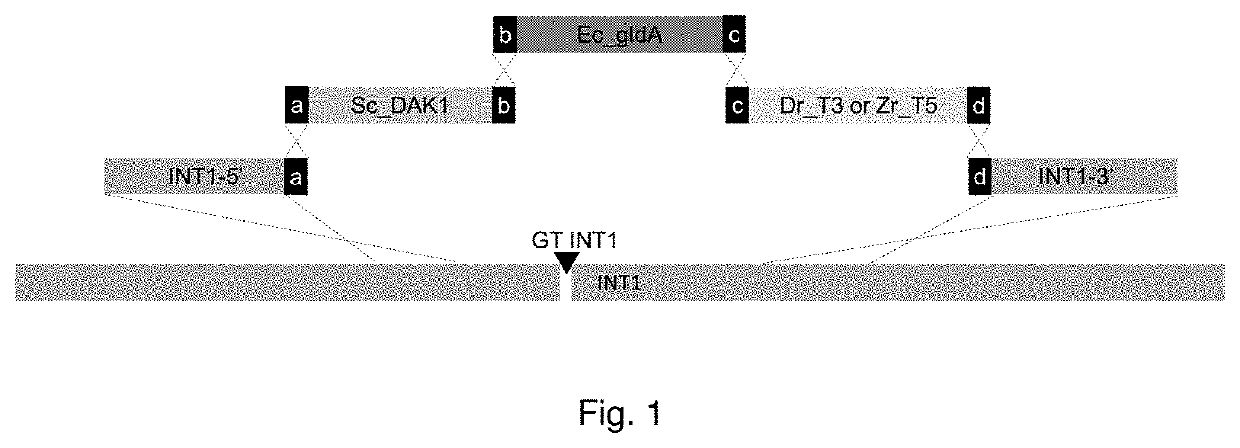Glycerol free ethanol production
a technology of glycerin-free ethanol and ethanol, which is applied in the direction of lyases, carbon-carbon lyases, transferases, etc., can solve the problems of imposing waste water treatment costs, important constraints on product yield, and toxic by-product formation
- Summary
- Abstract
- Description
- Claims
- Application Information
AI Technical Summary
Benefits of technology
Problems solved by technology
Method used
Image
Examples
example 1
Reuptake Expression Cassette Construction
[0171]Expression Cassette Construction
[0172]The open reading frames (ORFs), promoter sequences and terminators were synthesized at DNA 2.0 (Menlo Park, Calif. 94025, USA). The promoter, ORF and terminator sequences were recombined by using the Golden Gate technology, as described by Engler et al (2011) and references therein. The expression cassettes were cloned into a standard subcloning vector. The plasmids (listed in Table 1) containing the expression cassettes encoding the components of the glycerol re-uptake pathway are:[0173]pDB1332 (SEQ ID NO: 1) bearing expression cassette for glycerol dehydrogenase (EC 1.1.1.6) E. coli gldA under control of S. cerevisiae ENO1 promoter and S. cerevisiae CYC1 terminator,[0174]pDB1333 (SEQ ID NO: 2) bearing expression cassette for dihydroxyacetone kinase (EC 2.7.1.29, EC 2.7.1.28) S. cerevisiae DAK1 under control of S. cerevisiae TPI1 promoter and S. cerevisiae ENO1 terminator,[0175]pDB1334 (SEQ ID NO: ...
example 2
nstruction DS78742, DS78743 and DS78744
[0177]Approach
[0178]The followed strain construction approach is described in patent application PCT / EP2013 / 056623 and PCT / EP2016 / 050136. PCT / EP2013 / 056623 describes the techniques enabling the construction of expression cassettes from various genes of interest in such a way, that these cassettes are combined into a pathway and integrated in a specific locus of the yeast genome upon transformation of this yeast. PCT / EP2016 / 050136 describes the use of a CRISPR-Cas9 system for integration of expression cassettes into the genome of a host cell, in this case S. cerevisiae. In the construction of IMX774 a S. pyogenes Cas9 expression cassette was already integrated at the CAN locus. Upon introduction of an in vivo assembled gRNA-expressing plasmid and repair DNA fragments the intended modifications were made. Firstly, an integration site in the yeast genome was selected. DNA fragments of approximately 500 bp of the up- and downstream parts of the int...
example 3
ion Experiment
[0193]Propagation of Strains
[0194]Strains IME324, IMX774, DS78742, DS784743 and DS78744 were pre-grown at 30° C. and 280 rpm overnight under semi-aerobic conditions in Mineral Medium supplemented with 20 g / L glucose supplemented with 0.05 g / L uracil.
[0195]Preparation of AFM Experiment
[0196]The following day, the optical density at 600 nm was determined and cells were spun down by centrifugation. Four hundred ml of Mineral Medium containing approximately 50 grams of glucose per liter and 0.05 g / L uracil was inoculated with one the abovementioned strains to 0.075 g / L (dry weight). At specific time intervals samples were taken in order to measure biomass, residual sugars, glycerol and acetic acid, as well as the formation of ethanol.
[0197]Results Fermentation Experiment
[0198]The glycerol yield on glucose of strains IMX774, DS78742, DS78743 and DS78744 were 0.036, 0.014, 0.015. and 0.021 g / g, respectively, which corresponds to a 35%, 75%, 73% and 62%, respectively, decreas...
PUM
| Property | Measurement | Unit |
|---|---|---|
| ionic strength | aaaaa | aaaaa |
| temperature | aaaaa | aaaaa |
| ionic strength | aaaaa | aaaaa |
Abstract
Description
Claims
Application Information
 Login to View More
Login to View More - R&D Engineer
- R&D Manager
- IP Professional
- Industry Leading Data Capabilities
- Powerful AI technology
- Patent DNA Extraction
Browse by: Latest US Patents, China's latest patents, Technical Efficacy Thesaurus, Application Domain, Technology Topic, Popular Technical Reports.
© 2024 PatSnap. All rights reserved.Legal|Privacy policy|Modern Slavery Act Transparency Statement|Sitemap|About US| Contact US: help@patsnap.com









